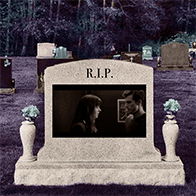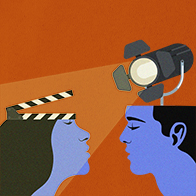Robots on the Silver Screen are Sentient, Sexy and Scary as Hell

Before the TV franchise, "Westworld"—written and directed by Michael Crichton and starring Yul Brynner—premiered in 1973. The popular movie challenged audiences who had little to no knowledge of artificial intelligence (AI) to imagine a world where they couldn't distinguish the difference between machines and humans.
Set in a wild-west theme park, the film interrogates the hypothesis of the "uncanny valley" theory. This is a term used to describe the relationship between the human-like appearance of a robotic object and the emotional response it invokes.
Author Isaac Asimov and other science fiction writers have touched on this metaphor many times in their books. Crichton's speculative fiction went beyond humans fighting robots, envisioning robots designed for sexual pleasure. He was anticipating a future where "sexbots" could be considered mainstream.
In 2016, a TV series adaptation of "Westworld" returned to HBO, but audiences 50 years removed from the original movie lived in a different world. Sexbots no longer shocked audiences. They were almost to be expected. From the 1977 movie "Star Wars" on, Hollywood producers recognized that robots turned on audiences and they never looked back, transforming Crichton's original concepts into a customary sci-fi trope.
But what was the attraction of audiences to sexualized machines? Technology often provokes both fear and admiration, and man-made robots are no exception.
Ancient Roman poet Ovid, speculated that humans would desire their own creations. This is dealt with directly in his poem, "Metamorphoses: Book X," which tells the story of Pygmalion, a sculptor whose creation, Galatea, awakened for him to love. (Note for culture buffs, this was also the inspiration for the 1913 play by George Bernard Shaw and the 1964 Hollywood movie "My Fair Lady" starring Audrey Hepburn and Rex Harrison.)
Rather than sculptures, though, sexbots onscreen represent idealized sexuality, created to be fetishized and feared.
"Erotic thrillers always need to have some sexualizing aspect, but there's danger involved as well, and this pleasure/danger factor is crucial to the genre," explained Nina Martin, Ph.D., an associate professor of film studies at Connecticut College in Hartford, Connecticut. "The majority of erotic thrillers circulate around a male character these days, and the woman-identifying characters, whether human, cyborg or AI, are most frequently the object of desire in combination with some danger."
Technophobia and technophilia
Technophobia is extremely common in sci-fi. Depictions of fearful humans who struggle to understand the dangerous implications of AI humanoid robots can unsettle audiences. It is difficult for us to categorize the humanity of these machines. And this dilemma is further complicated by our potential sexual desire for robots that look like people, a nudge toward encouraging us to see machines as erotic.
"I think there are a few layers of attraction to robot sex," said Nicoletta Heidegger, M.A., a licensed marriage and family therapist in Los Angeles, California. "Firstly, robots are made to do what we want them to, to be above or not be so prone to human flaws. Relationships and sex can be difficult and take work. It can feel like a nice fantasy to imagine a perfect partner who says and does what we ask for in just the right way."
Technophobia is quickly conflated with technophilia—an attraction to man-made beauty standards, materialized by AI. The tension between the titillating and frightening qualities of robots is what entices audiences, explained Bo Ruberg, Ph.D., associate professor of film and media studies at the University of California, Irvine.
It could be argued that the media plays a role in influencing the characteristics society finds attractive. In this way, technophilia may operate as a tool to communicate what's desirable to audiences. The cultural representation of sexbots could be said to expose how society views sexual desire and control to be interrelated, informing viewers what they should find "sexy."
"For many of us, media is our only sex education," said Susan Milstein, Ph.D., a master-certified health education specialist and certified sexologist in New York City. "Most folks did not get sex education, let alone a comprehensive sex education. So, unfortunately, a large percentage of our population is learning how to have sex from fantasy media portrayals."
The abused robots of "Westworld" and the fembots in "Austin Powers: International Man of Mystery" both evoke emotions of fear and desire. Both were designed within a male-driven narrative, and it could be argued these robots represent unrealistic, controllable beauty standards.
To overcome technophobia, machines are depicted as objects of desire, and in most cases, the sexualized AI rebel against their creators. Good examples of this storyline can be seen in the movies "Ex Machina" and "Morgan and the Machine."
"Thrillers and action films both fetishize the female cyborg while simultaneously dehumanizing it, making it a monster," Martin said. "The message is that mad scientists have to be careful when they are meddling with (pro)creation, whether through robotics or biotech, because: 'women are out of control.'"
Desire and a culture of control
The protagonists in science fiction often simultaneously desire and fear their creations.
In the movie "Ex Machina," a programmer wins a contest allowing him to spend time at his boss' estate where he meets Ava, a beautiful robot. He is invited to help determine the nature of Ava's abilities and consciousness. Both men are shown to desire her, even infatuated with her due in part to their self-confinement. Yet it soon becomes evident that Ava is much more self-aware and manipulative than either imagine and they become terrified by her sentience.
"I hate to say it, but the way these films situate these women as machines—to be looked at and controlled—speaks to the sexism that is still endemic in the United States," Martin said. "Especially since the majority of these cyborg women either spectacularly break down or disobey orders, and also represent impossible beauty standards."
This theme also challenges what we think about relationships. For nearly a century, these films indicated that attraction is commonly driven by desire exclusively.
"If we look back at Fritz Lang's 1927 movie 'Metropolis,' you see many of the same ideas playing out, where a woman is designed to be desirable at the behest of men and then veers dangerously out of control," she added.
However, that's not always the case. In director Maria Schrader's 2021 film "I'm Your Man," the plot centers on a scientist at the Pergamon Museum in Berlin, played by Maren Eggert, who is persuaded to live with a perfect sentient companion, Tom, for three weeks in order to secure funding for her research.
The film overturns the typical science fiction narrative and positions the masculine AI as the object of desire.
Still, "I'm Your Man" reinforces how society views partnership, defined by fantasies of control. Martin noted that many films focused on relationships with AI "reveal how humans would abuse AI and robots."
"At what point does it become non-consensual?" Heidegger asked. "Or perhaps that is the fantasy—that some folks want things to be unidirectional so we can have this entity be whatever we want it to be, at our mercy. We created it, we have power over it, and we turn it off when we want to. For some desires, this can be an alluring fantasy because we don't have to do the work that's needed in a relationship."
As erotic sci-fi continues to evolve, it remains a powerful lens through which to examine society's complex relationship with desire, control, and technology.




















